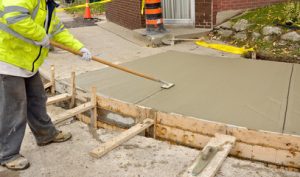Residential concrete services play a vital role in building durable, functional, and visually appealing outdoor and indoor spaces for homeowners. Concrete is one of the most versatile construction materials available, offering long-lasting performance and design flexibility for a wide range of residential applications. From structural foundations to decorative surfaces, professional GK Construction Solutions helps ensure quality results that stand the test of time.
Homeowners increasingly choose concrete solutions because of their durability, low maintenance requirements, and ability to complement various architectural styles. Understanding the scope of residential concrete services and their benefits helps homeowners make informed decisions when planning construction, repair, or improvement projects.

Understanding Residential Concrete Services
Residential concrete services encompass the installation, repair, and maintenance of concrete structures within residential properties. These services are designed to support both functional needs and aesthetic goals, creating surfaces that are safe, durable, and visually appealing.
Concrete can be customized through different finishes, textures, and reinforcement methods. Professional concrete services ensure that each project meets structural requirements while achieving the desired appearance.
Common residential concrete applications include driveways, walkways, patios, foundations, and slabs.
Why Concrete Is Ideal for Residential Projects
Concrete is widely used in residential construction due to its strength and adaptability. When properly installed, concrete surfaces can withstand heavy loads, weather exposure, and daily wear.
In addition to durability, concrete offers flexibility in design. Decorative options allow homeowners to achieve unique looks that enhance curb appeal and property value.
Key benefits of residential concrete include:
- Long-lasting strength and durability
- Versatile design options and finishes
These advantages make concrete a preferred choice for many residential projects.
Types of Residential Concrete Services
Residential concrete services cover a wide range of projects tailored to homeowners’ needs. Each service is designed to address specific functional and aesthetic requirements.
Installation services focus on creating new concrete surfaces, while repair and restoration services address existing damage. Maintenance services help preserve the integrity and appearance of concrete over time.
Professional concrete providers assess each project individually to determine the best approach and materials.
Concrete Driveways and Walkways
Concrete driveways and walkways are among the most common residential concrete services. These surfaces provide safe and durable access points while contributing to the home’s overall appearance.
Concrete driveways offer superior load-bearing capacity and long-term performance compared to other materials. Walkways benefit from smooth, slip-resistant finishes that improve safety.
Proper installation ensures even surfaces, effective drainage, and resistance to cracking.
Patios and Outdoor Living Spaces
Concrete patios create versatile outdoor living areas that enhance comfort and usability. These spaces can be designed for relaxation, entertainment, or dining.
Decorative concrete techniques allow patios to mimic the appearance of stone, brick, or tile while maintaining the durability of concrete. Textured finishes improve traction and visual appeal.
Concrete patios are customizable and designed to withstand outdoor conditions year-round.
Concrete Foundations and Slabs
Foundations and slabs are critical components of residential structures. Concrete provides the strength and stability needed to support buildings and protect them from shifting or settling.
Professional residential concrete services ensure proper site preparation, reinforcement, and curing. These steps are essential for creating foundations that maintain structural integrity over time.
High-quality concrete foundations contribute to the overall safety and longevity of the home.
Decorative Concrete Options
Decorative concrete has become increasingly popular in residential applications. Homeowners appreciate the ability to achieve unique designs without sacrificing durability.
Stamped, stained, and polished concrete finishes add character to patios, driveways, and interior floors. These techniques allow for customization while maintaining easy maintenance.
Decorative concrete enhances both interior and exterior spaces, adding value and visual interest.
Concrete Repair and Restoration Services
Over time, concrete surfaces may develop cracks, chips, or surface wear. Residential concrete repair services address these issues to restore function and appearance.
Repair techniques vary depending on the extent of damage. Minor cracks may be sealed, while more significant damage may require resurfacing or partial replacement.
Timely repairs help prevent further deterioration and extend the lifespan of concrete surfaces.
Importance of Proper Installation Techniques
Proper installation is essential for achieving durable concrete results. Residential concrete services involve precise mixing, placement, and curing processes.
Professionals follow established methods to ensure even surfaces and proper reinforcement. Attention to detail during installation reduces the risk of cracking and surface defects.
Quality installation contributes to long-lasting performance and reduced maintenance needs.
Weather and Environmental Considerations
Environmental factors play a significant role in residential concrete projects. Temperature, moisture, and soil conditions can affect concrete performance.
Professional concrete services account for these factors during planning and installation. Proper curing techniques protect concrete from weather-related issues and improve durability.
Considering environmental conditions ensures optimal results and long-term reliability.
Maintenance of Residential Concrete Surfaces
Although concrete is low maintenance, proper care helps preserve its appearance and strength. Regular cleaning and sealing protect surfaces from stains and moisture intrusion.
Maintenance routines may vary depending on surface type and exposure. Outdoor surfaces benefit from periodic inspections to identify early signs of damage.
Maintaining concrete surfaces extends their lifespan and enhances their visual appeal.
Choosing Professional Residential Concrete Services
Selecting experienced professionals is essential for successful concrete projects. Residential concrete services require specialized knowledge of materials, techniques, and design options.
Professional concrete services typically offer:
- Comprehensive project assessment and planning
- Skilled installation and reliable workmanship
Working with professionals ensures that projects are completed efficiently and to high standards.
Long-Term Value of Residential Concrete Services
Investing in residential concrete services provides long-term value for homeowners. Durable concrete surfaces reduce the need for frequent repairs and replacements.
Concrete improvements also enhance curb appeal and overall property value. Well-designed and maintained concrete features contribute to a positive first impression.
Long-term durability and aesthetic appeal make concrete a smart residential investment.
Sustainability and Concrete Use
Concrete is increasingly recognized for its sustainability benefits when used responsibly. Long-lasting concrete surfaces reduce material waste over time.
Modern concrete practices focus on efficient use of resources and improved durability. These approaches support environmentally conscious construction goals.
Sustainable concrete solutions align with modern residential building practices.
Residential concrete services offer homeowners reliable solutions for durable and attractive surfaces. From driveways and patios to foundations and decorative features, concrete provides unmatched versatility and strength.
Professional installation, repair, and maintenance ensure that concrete surfaces perform well and maintain their appearance. By choosing quality residential concrete services, homeowners can enhance functionality, safety, and long-term value.


